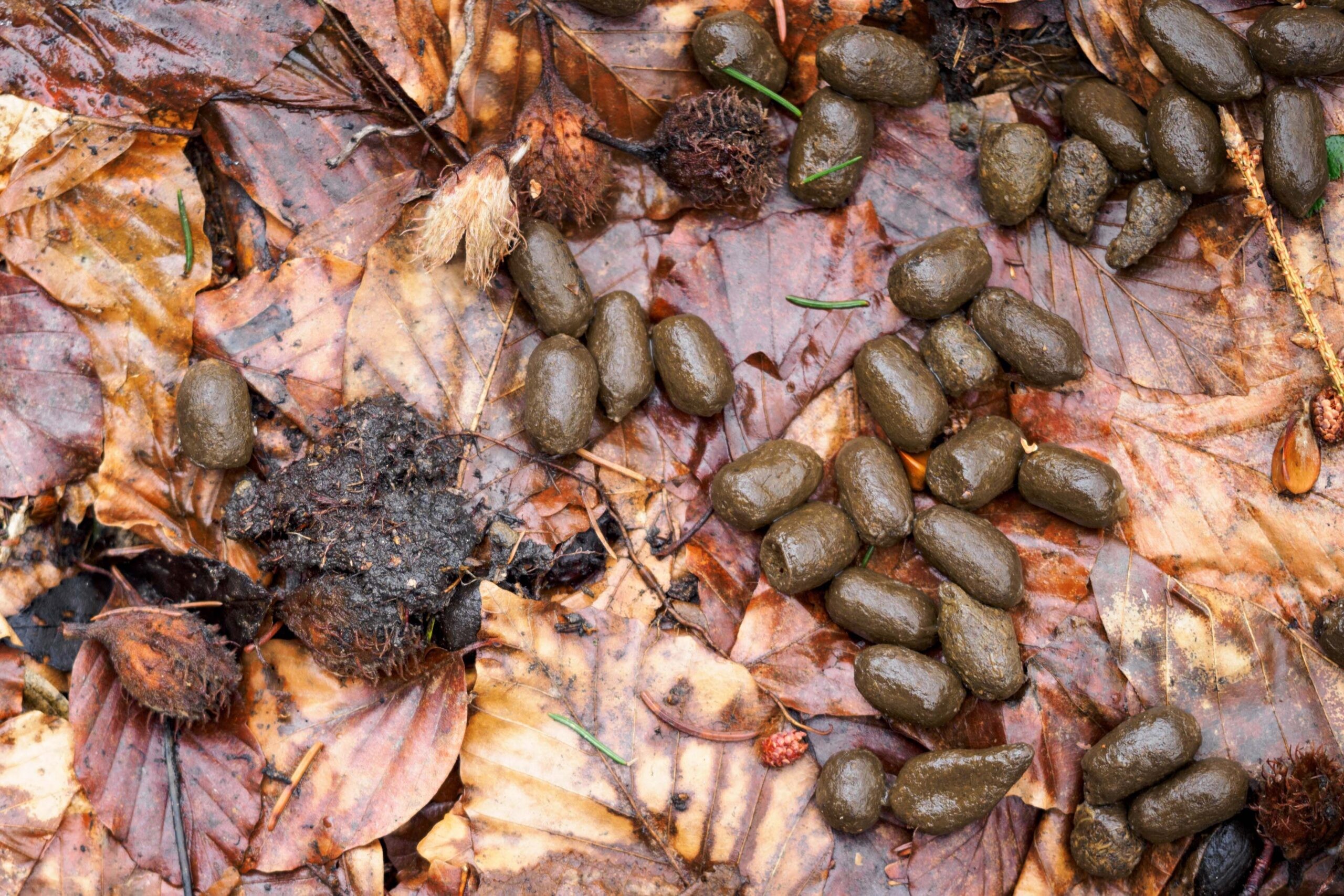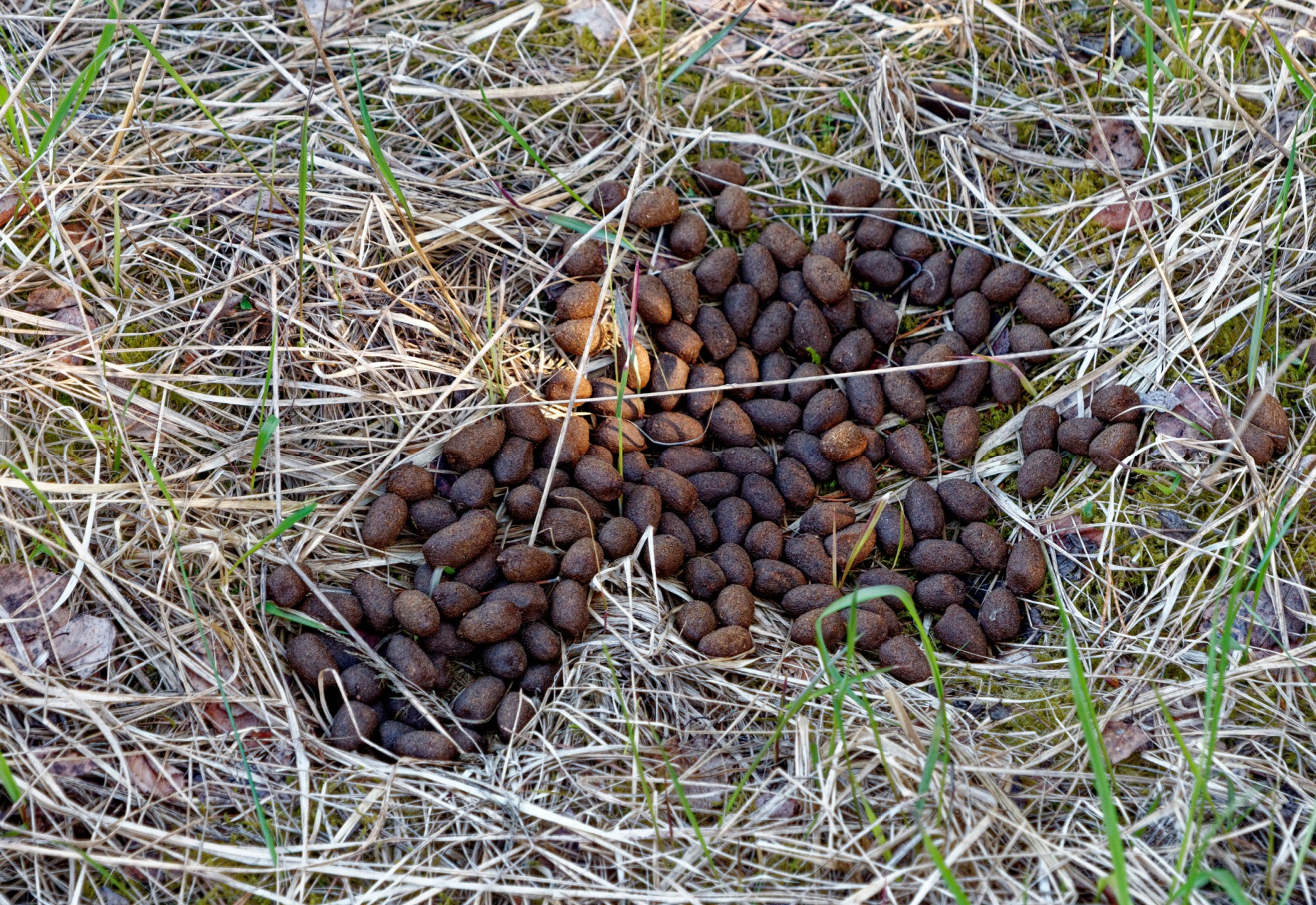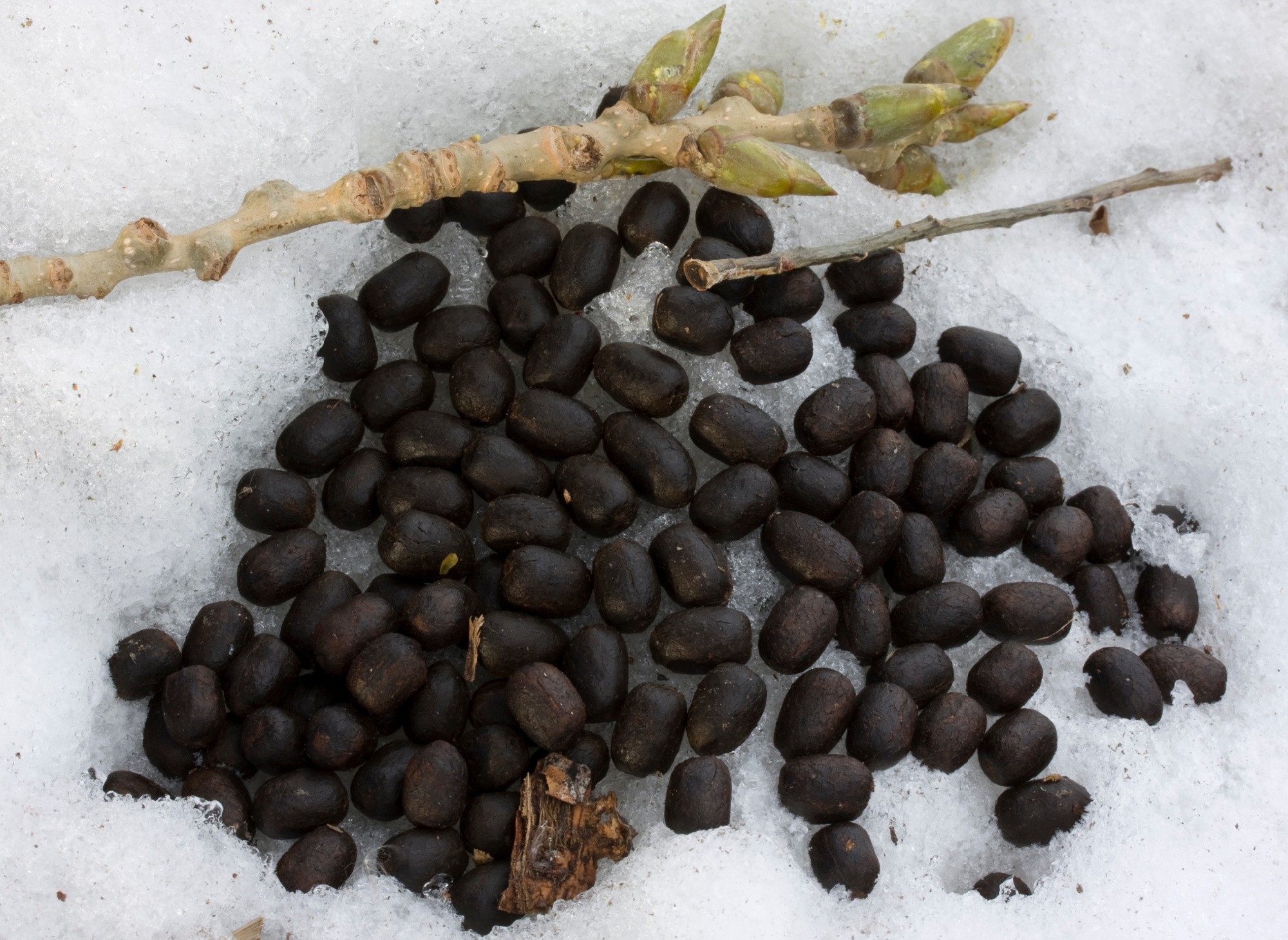Deer poop versus rabbit poop – distinguishing between these common wildlife signs can be crucial for gardeners, hikers, and nature enthusiasts alike. This comprehensive guide, brought to you by COMPARE.EDU.VN, will equip you with the knowledge to accurately identify deer and rabbit droppings, understand what their presence signifies, and differentiate them from other animal scat. Let’s explore the subtle yet significant differences in scat identification.
1. Understanding Deer Scat: Characteristics and Significance
Deer scat, often encountered in parks, gardens, and natural habitats, typically presents as piles of dark brown or black pellets. The appearance and frequency of deer droppings can reveal important information about deer activity, diet, and even their health.
1.1. Key Characteristics of Deer Poop
- Shape and Size: Deer pellets are typically oval or cylindrical, ranging from 0.2 to 0.5 inches in length.
- Color: Fresh deer poop is usually dark brown or black, gradually fading to lighter shades as it dries.
- Texture: The texture varies depending on the deer’s diet. In spring and summer, when deer consume lush vegetation, the droppings tend to be moist and clumpy. During drier seasons, the pellets become harder and more distinct.
- Distribution: Deer defecate frequently, leaving behind numerous piles of pellets in areas they frequent, such as feeding grounds, bedding sites, and travel routes.
1.2. What Deer Scat Tells Us
- Presence of Deer: The most obvious indicator is the presence of deer in the area.
- Diet: The consistency and composition of the scat can provide clues about what the deer are eating. For example, very moist scat may indicate a diet rich in succulent vegetation.
- Activity Patterns: The location of deer droppings can help identify areas where deer are actively feeding, bedding, or traveling.
- Herd Health: Wildlife biologists can analyze deer scat to monitor herd health, hormone levels, and disease prevalence, including chronic wasting disease.
2. Rabbit Droppings: Identification and Distinguishing Features
Rabbit droppings are another common sight in gardens and natural environments. Understanding the characteristics of rabbit scat is essential for distinguishing it from deer droppings and other animal waste.
2.1. Key Characteristics of Rabbit Poop
- Shape and Size: Rabbit pellets are typically small, round, and uniform in shape, resembling tiny peas. They are generally smaller than deer pellets, measuring about 0.25 to 0.5 inches in diameter.
- Color: Rabbit droppings are usually brown or dark brown.
- Texture: Fresh rabbit pellets are relatively dry and firm, composed primarily of undigested plant fibers.
- Distribution: Rabbits deposit numerous pellets in localized areas, often forming small piles or scattering them along trails and near feeding areas.
2.2. The Significance of Rabbit Scat
- Rabbit Presence: The presence of rabbit droppings indicates that rabbits are active in the area.
- Dietary Habits: Rabbit scat reflects their herbivorous diet, consisting mainly of grasses, herbs, and plant leaves.
- Habitat Use: The distribution of rabbit droppings can reveal information about their preferred habitats, feeding areas, and travel routes.
3. What Does Deer Poop Look Like Compared To Rabbit Poop? A Detailed Comparison
While both deer and rabbit droppings consist of small pellets, several key differences can help you distinguish between them. This section provides a detailed comparison of deer poop vs rabbit poop, focusing on shape, size, color, texture, and distribution.
3.1. Shape and Size Differences
- Deer Poop: Oval or cylindrical pellets, ranging from 0.2 to 0.5 inches in length.
- Rabbit Poop: Round pellets, about 0.25 to 0.5 inches in diameter.
Deer pellets tend to be slightly larger and more elongated than rabbit pellets, which are consistently round.
3.2. Color Variations
- Deer Poop: Dark brown or black when fresh, fading to lighter shades as it dries.
- Rabbit Poop: Brown or dark brown.
While both types of droppings share similar colors, deer poop may exhibit greater variation depending on its moisture content and age.
3.3. Texture and Composition
- Deer Poop: Varies from moist and clumpy to hard and distinct, depending on the deer’s diet.
- Rabbit Poop: Relatively dry and firm, composed of undigested plant fibers.
Deer scat tends to be more variable in texture than rabbit scat, which is typically dry and fibrous.
3.4. Distribution Patterns
- Deer Poop: Distributed in numerous piles of pellets throughout their range, often found in feeding areas, bedding sites, and travel routes.
- Rabbit Poop: Deposited in localized areas, forming small piles or scattered along trails and near feeding areas.
Deer scat is typically more dispersed than rabbit scat, reflecting their larger home ranges and more varied activities.
3.5. Quick Reference Table: Deer Poop vs Rabbit Poop
| Feature | Deer Poop | Rabbit Poop |
|---|---|---|
| Shape | Oval or cylindrical | Round |
| Size | 0.2 to 0.5 inches in length | 0.25 to 0.5 inches in diameter |
| Color | Dark brown or black, fading to lighter shades | Brown or dark brown |
| Texture | Varies from moist to hard | Dry and firm |
| Distribution | Numerous piles, widely dispersed | Localized piles or scattered pellets |



4. Differentiating Deer and Rabbit Scat from Other Animal Droppings
In addition to deer and rabbit droppings, other animal scats can be found in similar environments. This section will help you distinguish deer and rabbit scat from the droppings of other common wildlife species.
4.1. Elk Scat
Elk droppings are similar to deer poop but significantly larger. Elk pellets are typically cylindrical with a dimple on one or both ends, measuring about 0.5 to 1 inch in length.
4.2. Coyote Scat
Coyote scat is usually elongated and cylindrical, with a twisted or tapered shape. It often contains hair, bones, and other undigested remains of their prey. Coyote scat is typically larger than deer or rabbit droppings, measuring about 3 to 5 inches in length.
4.3. Bear Scat
Bear scat varies greatly depending on their diet. It can be large and cylindrical, or loose and shapeless. Bear scat often contains berries, seeds, insects, and other food items. The size and content of bear scat are much larger and more varied than deer or rabbit droppings.
4.4. Identifying Feces Chart
| Animal | Scat Description | Size |
|---|---|---|
| Deer | Oval or cylindrical pellets, dark brown or black | 0.2-0.5 inches |
| Rabbit | Round pellets, brown | 0.25-0.5 inches |
| Elk | Cylindrical pellets with dimples, dark brown | 0.5-1 inch |
| Coyote | Elongated, cylindrical, twisted, contains hair and bones | 3-5 inches |
| Bear | Large, cylindrical or loose, varies with diet, contains berries, seeds, insects | Variable |
5. Beyond the Pellets: Understanding the Broader Implications
Identifying animal scat is not just an exercise in natural history; it has practical implications for various fields, including wildlife management, conservation, and gardening.
5.1. Wildlife Management and Conservation
Wildlife biologists use scat analysis to monitor animal populations, assess their health, and study their dietary habits. Scat samples can provide valuable information about hormone levels, stress indicators, and the presence of diseases. This data helps inform conservation efforts and wildlife management strategies.
5.2. Gardening and Pest Control
Identifying animal droppings in your garden can help you determine which animals are visiting your property and potentially causing damage. Knowing whether you’re dealing with deer or rabbits can guide your pest control efforts, such as installing deer fencing or using rabbit repellents.
5.3. Hunting and Wildlife Observation
Hunters and wildlife observers use scat identification to locate areas where specific animals are active. Finding deer or rabbit droppings can indicate promising hunting spots or prime locations for wildlife viewing.
6. Deer Poop FAQ
6.1. Are deer droppings harmful?
No, deer droppings are not generally harmful to humans or pets. They consist of digested plant matter and pose little health risk. However, it’s always a good idea to wash your hands after handling animal droppings.
6.2. Where do deer usually poop?
Deer poop in various locations, including feeding areas, bedding sites, and travel routes. They often defecate after waking up or before settling down to rest.
6.3. Can I use deer poop in my garden?
Yes, deer poop can be used as a natural fertilizer. It contains nitrogen and other nutrients that can benefit plant growth. However, it’s essential to allow a period of at least 90 to 120 days between fertilizing with raw manure and harvesting any vegetables to minimize the risk of contamination.
6.4. Is deer poop a sign of a healthy ecosystem?
The presence of deer can indicate a healthy ecosystem, as they are an important part of the food chain. However, an overpopulation of deer can also have negative impacts, such as overgrazing and damage to vegetation.
6.5. How often do deer poop?
Deer poop frequently throughout the day, typically 10 to 30 times, depending on their diet and activity level.
6.6. Does deer poop smell?
Fresh deer poop has a mild, earthy odor. The smell becomes more pronounced as the droppings dry and decompose.
6.7. What does deer poop look like in different seasons?
In the spring and summer, deer poop tends to be moist and clumpy due to the lush vegetation they consume. In the fall and winter, the pellets become harder and more distinct as their diet shifts to drier foods.
6.8. Can deer poop attract other animals?
Yes, deer poop can attract insects, such as flies and dung beetles, which feed on the organic matter. It can also attract scavengers, such as coyotes and foxes, which may be drawn to the area by the presence of deer.
6.9. How long does deer poop last?
Deer poop typically decomposes within a few weeks to a few months, depending on environmental conditions such as temperature and humidity.
6.10. What do scientists learn from deer poop?
Scientists analyze deer poop to study their diet, hormone levels, stress levels, and the presence of diseases. This information helps them monitor herd health, assess the impact of environmental changes, and develop effective conservation strategies.
7. Need More Comparisons? Visit COMPARE.EDU.VN Today
Distinguishing between deer poop and rabbit poop is just one small piece of the puzzle when it comes to understanding the natural world around you. At COMPARE.EDU.VN, we provide comprehensive comparisons on a wide range of topics, from wildlife identification to product reviews. Whether you’re a nature enthusiast, a homeowner, or a savvy consumer, COMPARE.EDU.VN is your go-to resource for informed decision-making.
Are you struggling to make sense of conflicting information? Do you need help comparing different options before making a crucial decision? Don’t waste time searching through endless websites and unreliable sources. Visit COMPARE.EDU.VN today and discover a world of clear, concise, and objective comparisons.
Our team of experts meticulously researches and analyzes various topics, presenting you with the facts you need to make confident choices. Whether you’re comparing different types of animal scat, choosing the best gardening tools, or researching the latest tech gadgets, COMPARE.EDU.VN has you covered.
Take control of your decisions and visit COMPARE.EDU.VN today.
Address: 333 Comparison Plaza, Choice City, CA 90210, United States
WhatsApp: +1 (626) 555-9090
Website: compare.edu.vn
8. Conclusion: The Art of Scat Identification
Learning to identify deer and rabbit droppings is a valuable skill for anyone who spends time outdoors. By understanding the characteristics of their scat and how to differentiate it from other animal waste, you can gain insights into the presence, behavior, and health of these fascinating creatures. So, the next time you encounter a pile of pellets in your garden or on a hiking trail, take a closer look. You might be surprised at what you can learn.
